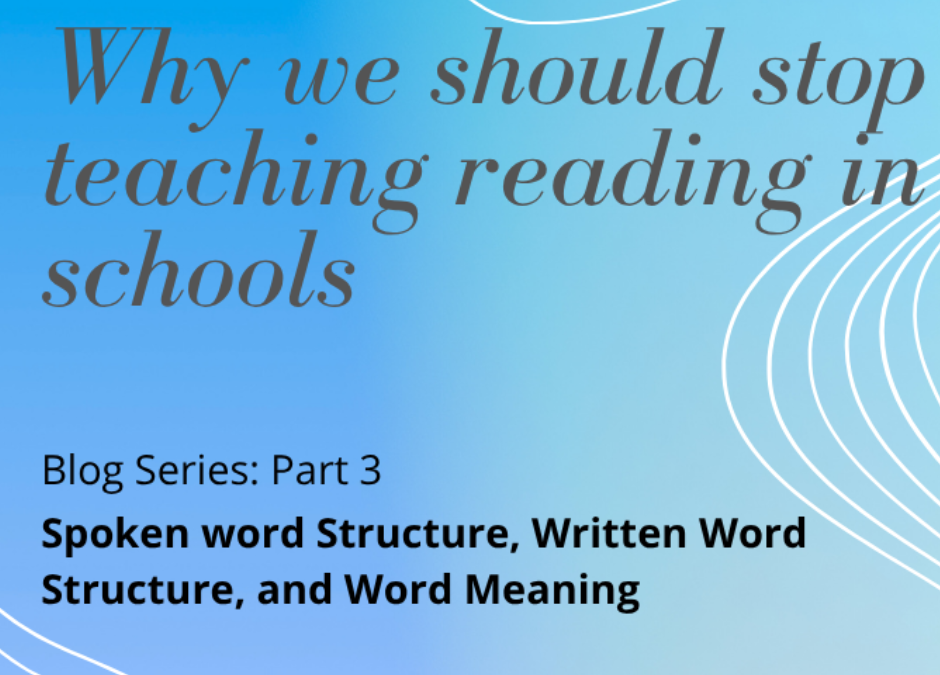Blog Series: Why We should STOP teaching reading in schools
Part 3: Spoken word Structure, Written Word Structure, and Word Meaning: MAPPING Language Units

This blog series explores the development of Written Language: reading, spelling, and writing as a natural extension from oral language to visual language. This blog series describes what reading IS – the integration of visual language (letters) into
already-existing oral language processing systems (sounds, words, and vocabulary). The brain can MAP or integrate a word into long-term permanent storage when it can “attach” 3 pieces of processing information together for a given language unit: what it looks like, what it sounds like, and what it means.
Mapping Letters
What do letters mean? Well, we NEED the letter’s name – this is like a category, a container – the label for the letter name anchors the letter in our vocabulary system and provides a “hook” for everything we will learn about a letter. What do you REALLY need to know about a letter, you ask? Well, check in on whether YOU have acquired all of this information below. Is any of it new to you? This is the letter B. It’s name is b. It is a tall stick with a bump on the Right-hand side. It is the 2 nd letter in the alphabet, and it says /b/, and I hear it in words like “ball” and “bus”. It looks a lot like the letter D, and the upper-case form looks quite a bit different from the lower-case form, unlike the letter P.
Explicit Instruction
EVERYONE knows we need “explicit instruction”. Have YOU every explicitly taught and talked about all of the above information to a child trying to learn the alphabet? And have you done so for all 26 letters, in their lower-case and upper-case form? Students need to know what a letter MEANS, including its name, and the conceptual information provided above. They need this information alongside knowledge of what the letter LOOKS LIKE – the visual SYMBOL that matches the letter’s name. They also need to know how to SAY the letter’s name, but ALSO what spoken sound the letter is supposed to represent.
Notice there are TWO pieces of sound-based information to letters – its name, AND its sound. This is why we may see difficulty with LETTER SYMOBLS specifically, but then not with NUMBERS, which just have one piece of spoken information – the number’s name. You can see alphabet learning is complex. A lot of students acquire it JUST from exposure and a little bit of instruction. If you have a student that is SLOW to acquire Alphabet naming, letter formation (reversals!!) or letter-sound correspondence (what does “s” say, which letter says /v/ etc.) Then you have all the red flags you need to START with language-based therapy to start to integrate or hook up the visual form of language to the spoken form.
Processing Assist
What works is to spell very short and simple words, including the child’s name. Say the word one sound at a time. Print the letter that represents that sound. Go one sound at a time. Say the corresponding SOUND as you print the letter. At the end, tap all the letters as you say the sounds one at a time. Now blend and say the whole word. Use the word in a contextual sentence or provide a definition. Now tap each letter and say it’s name. In this way, you are addressing what the word sounds like, means, and looks like; you are reinforcing sequencing; you are training what all the letters in the word look like and sound like, as well as their name (meaning). You are further pairing this with the HUGE motor complex in the brain, activating a ton of additional brain power. By saying the sounds as you print the letters, you are activating AT THE SAME TIME the “sounds” part of the brain with the “visual” part of the brain, and the motor system is providing a processing assist.
~
Watch for part 4 and beyond of this blog series as we discuss mapping words.
Read Intro: Why We should STOP teaching reading in schools
Read Part 1: What are the components of Oral language?
Read Part 2: What is Visual or Written Language, and how is it INTEGRATED?
Got questions, concerns, yeah buts? Visit www.speak2read.ca to engage in some delightful conversation on how you can improve your reading instruction or your child’s learning.

